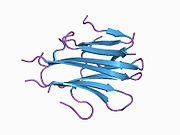TRAIL
Ensembl | |||||||||
|---|---|---|---|---|---|---|---|---|---|
| UniProt | |||||||||
| RefSeq (mRNA) | |||||||||
| RefSeq (protein) | |||||||||
| Location (UCSC) | Chr 3: 172.51 – 172.52 Mb | Chr 3: 27.37 – 27.4 Mb | |||||||
| PubMed search | [3] | [4] | |||||||
| View/Edit Human | View/Edit Mouse |
In the field of cell biology, TNF-related apoptosis-inducing ligand (TRAIL), is a protein functioning as a ligand that induces the process of cell death called apoptosis.[5][6]
TRAIL is a
TRAIL has also been designated CD253 (cluster of differentiation 253) and TNFSF10 (tumor necrosis factor (ligand) superfamily, member 10).[7]
Gene
In humans, the gene that encodes TRAIL is located at chromosome 3q26, which is not close to other TNF family members.[5] The genomic structure of the TRAIL gene spans approximately 20 kb and is composed of five exonic segments 222, 138, 42, 106, and 1245 nucleotides and four introns of approximately 8.2, 3.2, 2.3 and 2.3 kb.
The TRAIL gene lacks
The TRAIL gene as a drug target
TIC10 (which causes expression of TRAIL) was investigated in mice with various tumour types.[8]
Structure
TRAIL shows homology to other members of the
Function
TRAIL binds to the
The TRAIL receptors as a drug target
In clinical trials only a small proportion of cancer patients responded to various drugs that targeted TRAIL death receptors. Many cancer cell lines develop resistance to TRAIL and limits the efficacy of TRAIL-based therapies.[14]
Interactions
TRAIL has been shown to
See also
References
- ^ a b c GRCh38: Ensembl release 89: ENSG00000121858 – Ensembl, May 2017
- ^ a b c GRCm38: Ensembl release 89: ENSMUSG00000039304 – Ensembl, May 2017
- ^ "Human PubMed Reference:". National Center for Biotechnology Information, U.S. National Library of Medicine.
- ^ "Mouse PubMed Reference:". National Center for Biotechnology Information, U.S. National Library of Medicine.
- ^ PMID 8777713.
- PMID 8663110.
- ^ a b "TNFSF10". NCBI Gene.
- ^ S2CID 76236123.
- PMID 30101145.
- ^ ONC201: Stressing tumors to death. Feb 2016
- PMID 18276109.
- S2CID 52149418.
- PMID 30154833.
- PMID 22580613.
- S2CID 38403545.
- PMID 9311998.
- PMID 10549288.
Further reading
- Almasan A, Ashkenazi A (2004). "Apo2L/TRAIL: apoptosis signaling, biology, and potential for cancer therapy". Cytokine & Growth Factor Reviews. 14 (3–4): 337–48. PMID 12787570.
- Cha SS, Song YL, Oh BH (2004). "Specificity of molecular recognition learned from the crystal structures of TRAIL and the TRAIL:sDR5 complex". TRAIL (TNF-Related Apoptosis-Inducing Ligand). Vitamins & Hormones. Vol. 67. pp. 1–17. PMID 15110168.
- Song C, Jin B (2005). "TRAIL (CD253), a new member of the TNF superfamily". Journal of Biological Regulators and Homeostatic Agents. 19 (1–2): 73–7. PMID 16178278.
- Bucur O, Ray S, Bucur MC, Almasan A (May 2006). "APO2 ligand/tumor necrosis factor-related apoptosis-inducing ligand in prostate cancer therapy". Frontiers in Bioscience. 11: 1549–68. PMID 16368536.
- Strandberg J, Louie AD, Lee S (June 2023). "TRAIL agonists rescue mice from radiation-induced lung injury". bioRxiv. S2CID 259213466.
External links
- [1] Apoptosis, Trail & Caspase 8 - The Proteolysis Map-animation
- PDB: 1D2Q
- TRAIL+Protein at the U.S. National Library of Medicine Medical Subject Headings (MeSH)
- Overview of all the structural information available in the PDB for UniProt: P50591 (Tumor necrosis factor ligand superfamily member 10) at the PDBe-KB.





